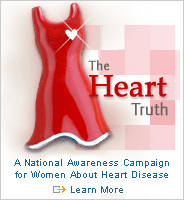 The Facts: Women and Heart Disease
The Facts: Women and Heart Disease 
Progress is being made in the fight against heart disease in women – more and more women are aware that heart disease is their #1 killer, and fewer women are dying from it. But heart disease continues to be the #1 killer of women, and most women still do not take heart disease seriously and personally. The information that follows includes newly-analyzed data about the status of heart disease in women today.
The Good News
- Overall heart disease deaths in American women are decreasing. Of the women who died in 2005 (the most recent year for which data are available), 1 in 4 died of heart disease.
- The last six years in particular have seen a steady decline in the number of heart disease deaths in women –deaths have gone down in each of the six years from 2000 to 2005, a consecutive yearly decline which has not occurred before.
- Women are living longer and healthier lives, and dying of heart disease at much later ages than in past years. In 2005, about half of all heart disease deaths in women occurred at or after age 85. In contrast, 40 years earlier (1965), the vast majority of women who died of heart disease (80 percent), died at earlier ages.
- Awareness among women of heart disease as their #1 killer has increased from one-third in 2000 to about three-fifths in 2008.
- Today in 2008, 61 percent of women recognize the Red Dress as the national symbol for women and heart disease awareness, up from 25 percent in 2005 and zero percent before 2002.
The Bad News
- Still, heart disease is the number one killer of women in the United States.
- In 2005, heart disease killed more women than stroke, chronic lower respiratory diseases, Alzheimer’s disease, diabetes, influenza, pneumonia, and kidney disease combined. Heart disease also kills more women than all forms of cancer and diabetes combined.
- Each year, since in 1991, more women than men have died of heart disease. In addition, 38 percent of women die within a year of having a heart attack, compared to 25 percent of men.
- About one-third of women still underestimate their own personal risk of heart disease based on their medical history and risk factors. Yet millions of women have one or more risk factors that place them at seriously increased risk of developing heart disease.
Heart disease is more serious among women of color. African American and Hispanic women, in particular, have higher rates of some risk factors for heart disease and are disproportionately affected by the disease compared to white women.
More than 80 percent of midlife African American women are overweight or obese, 52 percent have hypertension, and 14 percent have been diagnosed with diabetes. Some 83 percent of midlife Hispanic women are overweight or obese, and more than 10 percent have been diagnosed with diabetes.



